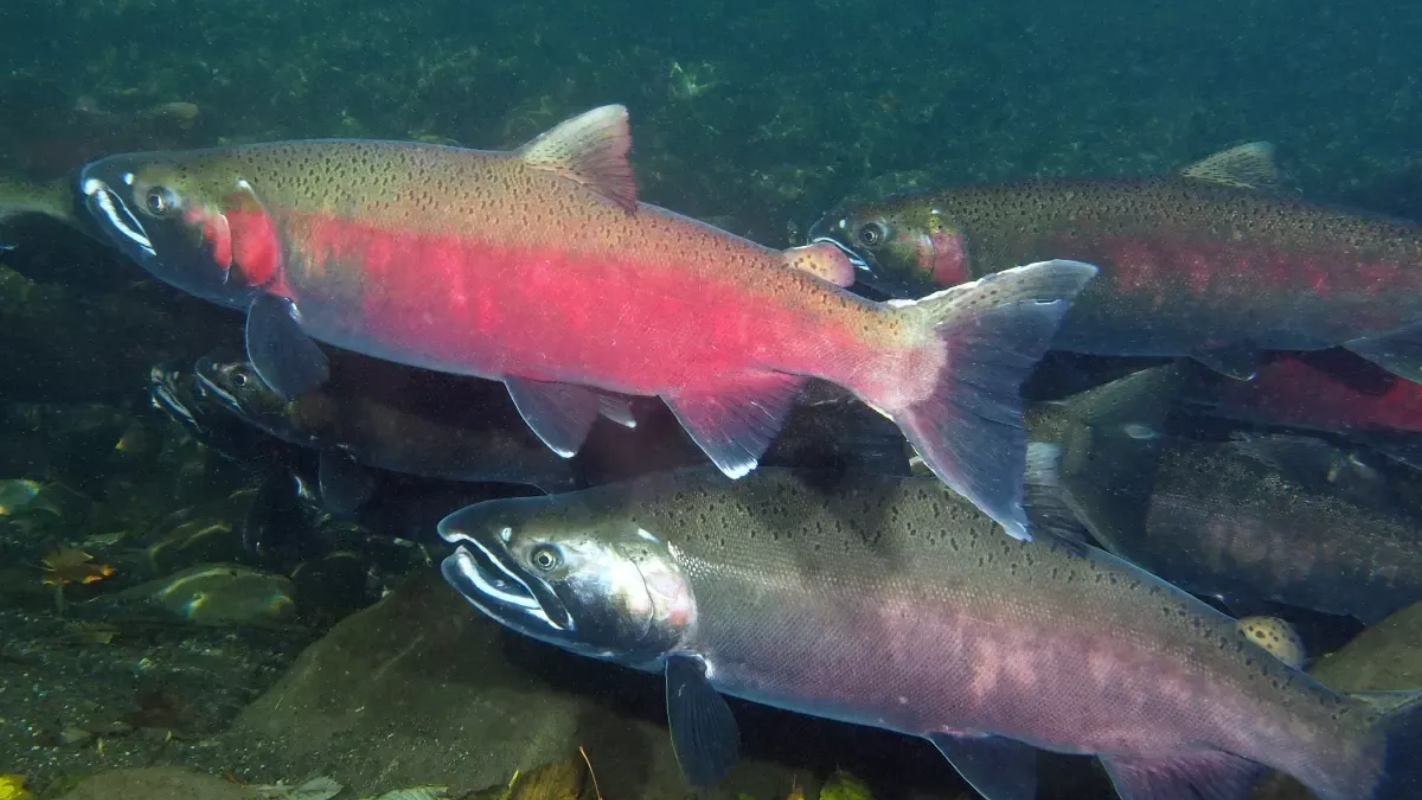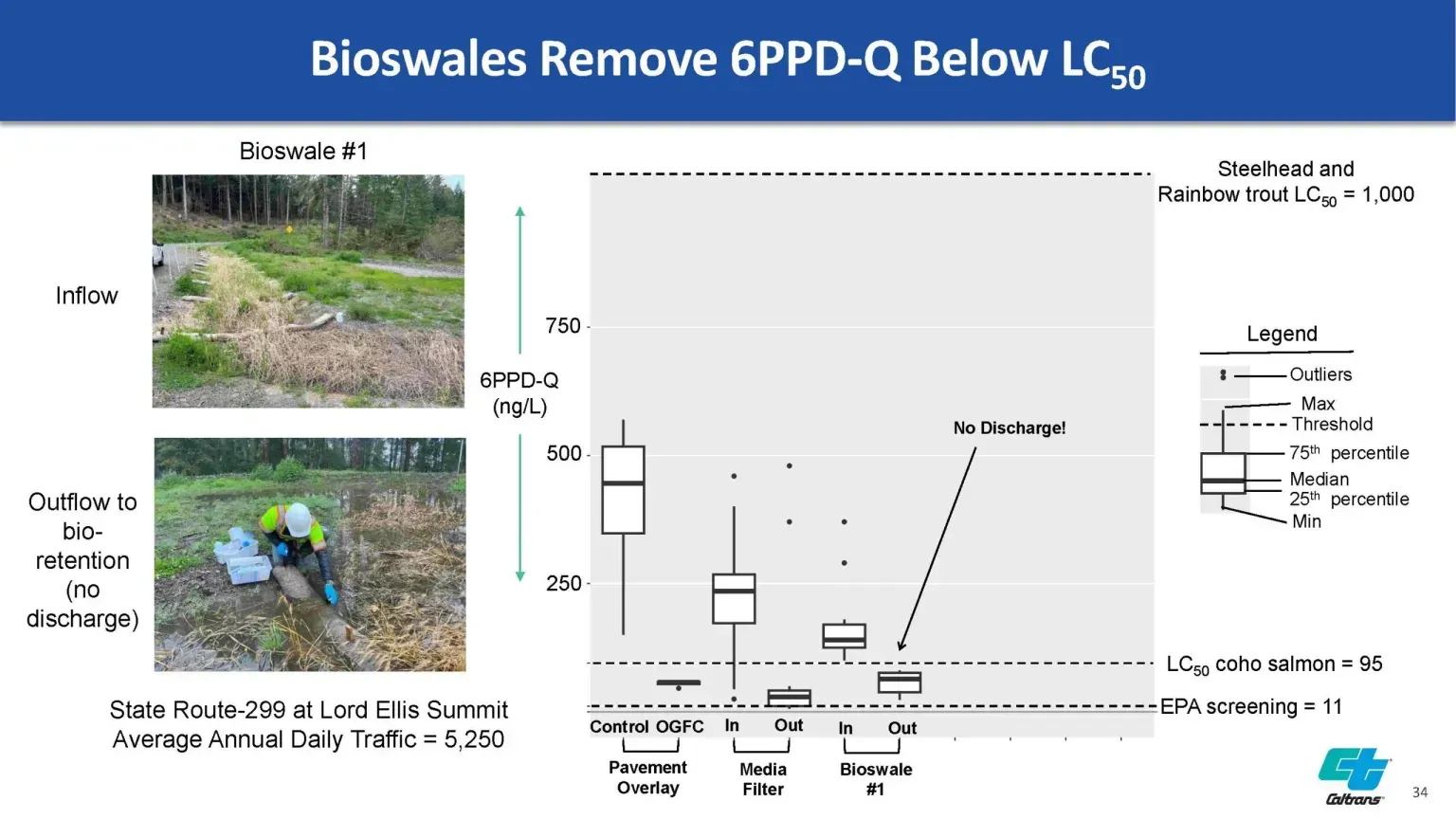A Pollutant in Tire Wear Particles is Killing West Coast Salmon at Alarming Rates
September 17, 2025
An overview of 6PPD-Q pollution and what CSE is doing about it.

BACKGROUND - 6PPD-Q is causing 90%+ mortality in urban streams during fall spawning migrations
Healthy salmon mean healthy watersheds. But for the past two decades, researchers in the Pacific Northwest have been alarmed by the urban runoff mortality syndrome (URMS) in coho salmon. In 2020, researchers identified a specific chemical in stormwater that was directly linked to URMS. The chemical, 6PPD-Q, forms from an antiozonant, 6PPD, which has been used in tires to extend their lifespan since the 1960s. 6PPD-Q is acutely toxic to coho and, to a lesser degree, steelhead and chinook. Mortality occurs most often during the early fall, when spawning fish encounter a flush of pollution caused by buildup of tire wear particles over the long dry summer months. These flushes also occur after any extended dry period throughout the year.
Significant mortality events have been documented for decades and across many urban watersheds. For example, Scholtz (2011) describes a 60%-100% pre-spawn mortality event in Longfellow creek, west Seattle, a range found often in the literature. In California, Oregon, and Washington, the chemical has been detected in streams and stormwater runoff at concentrations shown to kill at least half of coho in laboratory studies. In terms of lethal concentrations to detect, the adult 24-hour lethal concentration associated with 50% mortality (LC50) for juvenile coho salmon is 0.095 micrograms per liter (μg/L) whereas the 3-week post-swim up stage for coho salmon has an LC50 of 0.041 μg/L. Rainbow trout are also sensitive but at higher concentrations with an LC50 ranging from 1.0 to 2.3 μg/L during 72- and 24-h exposures, respectively. Steelhead LC50 has been found to be about 1.0 ug/L.
Landscape modeling has shown that the severity of spawner mortality scales with the extent of imperviousness within a watershed and, more specifically, the density of motor vehicle traffic near spawning habitats. Other factors include whether the stormwater runoff into receiving waters is mostly treated or untreated, traffic volume, heavier vehicles, more lanes, higher speeds, more turning and stopping, more impervious surface and absence of natural infiltration processes.
SOLUTIONS - Phasing out 6PPD in tires and advanced stormwater controls are two priority interventions
Tackling the 6PPD-Q issue comes down to two basic approaches. The first is a rapid phase-out of the additive 6PPD in tires. This additive has been used in tires since the early 1960s. Its main purpose is to extend tire life. According to the Interstate Technology Regulatory Council, 6PPD protects the components of the tire from degrading via ozone, oxygen, thermal degradation, and mechanical fatigue. Eliminating 6PPD in tires without an available alternative that offers comparable performance would compromise tire safety. For this reason, the search for 6PPD alternatives is in high gear, but will take time. Entities with active alternatives research include Washington Department of Ecology, California's Safer Consumer Products Program, the USDA, University of California and Flexsys, a major 6PPD manufacturer. Despite all these efforts, the reality is that 6PPD pollution will be around either in new tires or legacy tires still on the road for decades.
Because of this, CSE and its partners have begun researching what it would take in terms of policy changes and financial resources to put in place several promising controls on stormwater discharges to filter out this pollutant before it reaches critical habitat streams used by coho, Chinook, and steelhead. Advanced stormwater controls with the greatest promise include media filters, porous asphalt, and bio filtration. Ideally, all untreated stormwater outfalls would be prioritized for treatment with these technologies since most of the salmon mortality from 6PPD-Q now comes from outfalls with no treatment at all.

As part of its 6PPD-Q research and monitoring program, CalTrans has investigated the efficacy of these three types of stormwater controls and found that in each case, significant reductions in 6PPD-Q concentrations were achieved. BMPs monitored include:
- Media filters: A media filter BMP uses a bed of sand, peat, zeolite, anionic and/or cationic media, granite or other fine-grained materials or fabrics to physically separate sediment and sediment-bound pollutants and/or electro-chemically remove dissolved constituents from storm water (County of San Diego, 2018). Stormwater media filters are usually housed within a two-chambered structure including a pretreatment settling basin and a filter bed filled with sand or other absorptive filtering media.
- Porous pavement: Pervious or porous pavements allow stormwater to filter through voids in the pavement surface into an underlying rock reservoir where it is temporarily stored and infiltrated into the surrounding materials. While porous pavement designs may vary, they all have a similar structure consisting of a surface pavement layer with an underlying reservoir layer. Importantly, a porous asphalt layer can be installed as part of the original roadway design (i.e. for new roads) or when major reconstruction is needed or overlaid on existing asphalt.
- Biofiltration or bioretention: Biofiltration is the process of improving stormwater or wastewater quality by filtering water through biologically influenced media. In less technical terms, it means filtering polluted water through various facilities that rely on natural vegetation and soils to a large extent but which often include artificial filtration media as well. Biofiltration facilities are often paired with bioretention facilities that store the treated water and percolate it underground.
Results show promise. In each case, CalTrans found that BMPs reduced 6PPD-Q concentrations below the LC50 95 nanogram per liter for coho, and well below critical thresholds for chinook and steelhead (Figure below).

CSE's PROGRAM OF WORK - Citizen science and land use advocacy
6PPD-Q is an emerging issue for federal, state, and local public agencies and for CSE. CSE is now in the formative stages of a campaign to halt all new residential and commercial developments that fail to include these advanced stormwater controls and to help county governments identify, cost out, and plan for large scale installation of BMPs once funding becomes available. Our program of work includes the following activities:
Engaging communities, tribes and stakeholders at public workshops
CSE and its partners will be sponsoring a series of public workshops providing an overview of the 6PPD-Q issue and outlining what local actions our organizations are taking to combat this threat. Nonprofits, tribal leaders, fisheries advocates and experts will be invited to help plan and prepare for these workshops. In addition to providing a detailed science and policy overview of the issue, we will utilize these workshops as a way to recruit citizen scientists to help with the task of monitoring 6PPD-Q pollution during storm events that come on the heels of extended dry periods. Citizen scientist volunteers will be required to attend a training workshop prior to field work and familiarize themselves with the latest standard operating procedures issued by Washington Department of Ecology for sampling stormwater from pre-selected outfalls.
Monitoring 6PPD-Q pollution with citizen scientists
Despite the fact that 6PPD-Q pollution is now widely accepted as the single most important toxic contamination threat to salmonids, federal, state, and local public agencies have yet to ramp up sampling of stormwater from high-risk outfalls, which include those within critical habitat reaches and adjacent to large areas of impervious surface and high traffic roadways. Testing is not yet required by EPA or state agencies, so citizen science teams have an important role to play in identifying pollution hot spots.
CSE has already done the advance work to identify high risk areas in some Pacific Northwest regions, so it will be relatively easy for us to identify specific outfalls that should be prioritized by our citizen scientist teams. Grab samples will be captured using the Washington State Department of Ecology’s “Collecting Grab Samples from Stormwater Discharges” protocol and sent to the EuroFins laboratory in Sacramento, CA, which is currently being used for 6PPD-Q testing by public agencies in the Northwest.
Leveraging advanced stormwater controls via SEPA and ESA
New greenfield developments for residential or commercial purposes greatly exacerbate the 6PPD-Q issue by creating new, high traffic impervious surface areas that drain into critical habitat for listed salmonids. The only way such developments can be 6PPD-Q neutral is by careful set asides of greenspace (including stream buffers) and installation of biofiltration, media filter, or porous asphalt BMPs as conditions or mitigation measures required by land use or water quality permits.
Land use permits are subject to review under Washington’s State Environmental Policy Act (SEPA). Among other requirements, SEPA requires mitigation of any unavoidable environmental impacts, including water pollution. CSE and its partners will participate in the SEPA review process by offering technical comments addressing the risks of 6PPD-Q pollution and recommend types and locations of BMPs that have high likelihood of lowering pollution concentrations below the thresholds of concern discussed above. If our recommendations are ignored, we will pursue litigation if we can find pro-bono representation or a donor to assist with costs. CSE has won two cases already in Washington State under SEPA and is working with some of the most talented attorneys on this statute, so we are hopeful about leveraging SEPA for 6PPD-Q mitigation measures if needed.
Water quality permits – in particular, those required under Section 404 of the Clean Water Act – are often required for these new developments when wetlands or streams are dredged, filled, or otherwise degraded by proposed developments. CSE has a track record of monitoring, commenting on, and litigating Army Corp of Engineers issuance of these permits without adequate consideration of direct, indirect, and cumulative impacts. Our successful litigation against the Army Corps in Virginia, for example, led that agency to issue new regulations for complying with the National Environmental Policy Act (NEPA) in the context of 404 permits issued in association with new greenfield developments and has helped us both scale back the extent of new impervious surfaces and scale up green infrastructure elements such as forest and riparian buffers. To combat 6PPD-Q, we intend to follow a similar approach and have already signed up to be notified when the Seattle District of the Army Corp opens new 404 permits up for comment.
Creating shovel-ready lists of advanced stormwater BMPs and associated costs
For the vast area of impervious surface that already exists, CSE and its partners will work with city and county planning, engineering, and fisheries staff to identify priority sites for installation of BMPs in advance of funding anticipated as a result of litigation and/or funding made available through routine infrastructure spending at the state and federal levels. We have done preliminary work on this approach in Gresham, OR, Bellingham, WA, and Eureka CA. In these places, CSE modeled what it would take to treat all impervious surface areas within 1/4 mile of critical habitat streams for listed species and for all high traffic roadways within critical habitat watersheds. We will be expanding this work to include many other jurisdictions.
Please stay tuned here for further developments on CSE's 6PPD-Q work in the months ahead.


